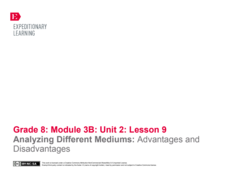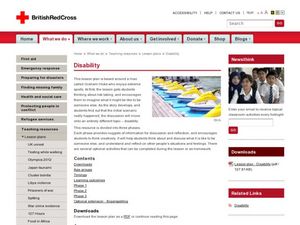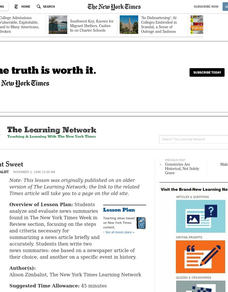Newspaper Association of America
Cereal Bowl Science and Other Investigations with the Newspaper
What do cereal, fog, and space shuttles have to do with newspapers? A collection of science investigations encourage critical thinking using connections to the various parts of the newspaper. Activities range from building origami seed...
Discovery Education
Election in the News
Young people are the future voices of the country. In order to be knowledgeable about local and federal elections, future voters must first become aware. Bring an informative lesson plan to your social studies class, in which middle and...
Newseum
Recognizing Bias: Analyzing Context and Execution
Young journalists learn how to identify bias in the news media. First, they watch a video in which a Newseum expert identifies bias in a story about the 1919 Chicago race riots. They then use what they have learned to analyze a recent...
EngageNY
Analyzing Different Mediums: Advantages and Disadvantages
How do authors play to people's moods? After briefly reviewing mood using a Conditional and Subjunctive Mood handout, learners practice identifying conditional and subjunctive sentences in the Montgomery Bus Boycott speech before reading...
Curated OER
Part of it All
Students take a closer look at the organization of newspapers. In this journalism lesson, students take virtual tours of newspapers and complete a newspaper puzzle handout. Students then compare the layout of weekly rural newspapers to...
Curated OER
Tonight's Homework - Watch Cartoons
Second graders explore various forms of media and its influence on their daily lives. Through an exploration of newspaper, commercial advertisement and audio media, they discuss the way media is used and how it can influence decision...
Curated OER
Disability
Students examine the role of media when dealing with the disabled. They participate in a community audit of different facilities and how they help the disabled.
Curated OER
High Exposure
Students interpret data they receive from the media, discuss possible misinterpretation of data from the media and correctly respond to the misconception quiz question.
Curated OER
Short But Sweet
After analyzing and evaluating news summaries found in the New York Times "Week in Review" section, middle schoolers study the steps for summarizing a news article briefly and accurately. They write two news summaries: one on a newspaper...
Curated OER
Propaganda
Ninth graders examine local examples of propaganda, such as election or political ads in order to identify types of propaganda and find examples of these in various media.
Curated OER
The War of the Worlds
Students discover the concept of media based on literature. In this War of the Worlds lesson, students read the novel The War of the Worlds by H.G. Wells and listen to the 1938 radio broadcast adaptation by Orson Welles. Students then...
Curated OER
No Publicity, Bad Publicity?
Students examine the factors that can influence a celebrity's media image and marketplace viability. They read an article, answer discussion questions, role-play advisors to a studio head, and write a letter to a studio head.
Curated OER
Media Scrapbook
High schoolers analyze the fundamental issues relating to Canadian parliamentary democracy through the exploration of media and public opinion. A scrapbook is created containing summaries of the work performed.
Curated OER
he Inauguration and the Media
High schoolers read, review, and write about the presidential inauguration as it appears in the media. They use local local and national newspapers to gain information about the inauguration. Students develop their own editorial on the...
Curated OER
Persuasive/Argumentative Essay vs. Opinion writing
Reinforce persuasive and argumentative writing skills with this lesson, which utilizes SchoolNet News Network's website/SNN Monthly magazine. Young writers review journalism writing styles that help them explain that writing a persuasive...
Curated OER
Fact vs. Opinion (Part II)
How can you tell the difference between fact and opinion? Using newspapers, learners determine which articles contain statements of fact, and which articles reflect the writer's opinion. The lesson plan includes a discussion format and a...
Curated OER
Advertising Conversation
Are you struggling to get a rich discussion going between your learners? Use these questions to spark a natural conversation about advertising and the media. Learners pair up, and each speaker gets a different set of questions to ask...
Stanford University
Explosion of the Maine
An intriguing lesson features newspaper articles to help academics understand the political impact of the sinking the Maine and how the American media depicted the event. Scholars also view a presentation, participate in group...
Curated OER
Race to the Presses
Students explore how the news media relays information about race in the United States by creating collages from newspapers and magazines and by sharing their reflections about the responsibilities of the news media in covering...
Curated OER
The Reader's Recourse
Students discover the recourse newspapers face for reporting wrong information. After reading an article, they examine the dispute between a pharmaceutical company and the New York Times. They evaluate the roles of the editor and the...
Curated OER
Your Angle on the Story
Students review several articles on same current event, and then cover news issues themselves while assuming secret identities of various individuals who have vested interests in issue. Students write newspaper articles from these...
Curated OER
Hurricane Katrina: You Be the Reporter
Students work in a small group to create news stories, feature stories and editorials/letters to the editor and organize them in a podcast, video-based program, or newspaper/magazine focused on Hurricane Katrina.
Curated OER
A Better Class of Journal-ists
Young academics create a current events journal by skimming newspapers for articles that fit defined guidelines for informational texts. After cutting out two articles each week to add to their journals, they write a brief description of...
Newseum
Front Page Photographs: Analyzing Editorial Choices
Frontpage photographs are the focus of four activities that ask young journalists to consider what the images reveal about a newspaper and its community. To begin, groups compare what images different papers from across the country use...

























